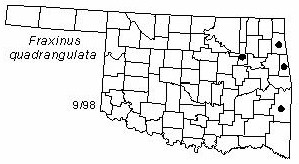Tree to 25 m (80 ft) in height and 1 m (3 ft) in diameter. The crown is rounded and slender. Bark: light brown to gray, fissured. Twigs red-brown, stout, pubescent when young, conspicuously 4-angled, sometimes 4-winged. Leaves opposite, pinnately compound, with 5-11 leaflets; leaflets oblong, lanceolate to ovate, 4-10 cm (1.5 to 4 in) long, 2.5-4 cm (1-1.5 in) wide; glabrous, with tufts of hair on the midvein beneath; acuminate at apex; rounded to cuneate at base; margins serrate with short incurved teeth; rachis slender and typically glabrous. Inflorescence a panicle of very small flowers; calyx obscure; corolla absent; style divided into two lobes; stamens 2; flowers appear from April to May. Fruit a samara, 2.5-5 cm (1-2 in) long and 6-12 mm (1/4-1/2 in) wide; fruits mature in October.
Distribution: Oklahoma and Arkansas, east to Alabama, north to Minnesota and Ontario. Uncommon in eastern Okahoma.
Habitat: moist soils and below limestone outcrops.
Comment: Fraxinus is the old Latin name for a species of European ash; quadrangulata refers to the 4-angled stems.
Horticulture: blue ash is an excellent shade tree.
Economic value: pioneers extracted a blue dye from the inner bark by immersion in water. The wood is used as flooring, baseball bats, furniture, tool handles, crates and barrels. The wood resembles white ash (F. americana) and is sold as such.
NWI status: none
Distribution in Oklahoma: 
BACK
NEXT
RETURN TO INDEX
Last update: 9/10/99
 Go to Oklahoma Biological Survey Home Page
Go to Oklahoma Biological Survey Home Page
 Disclaimer
Disclaimer